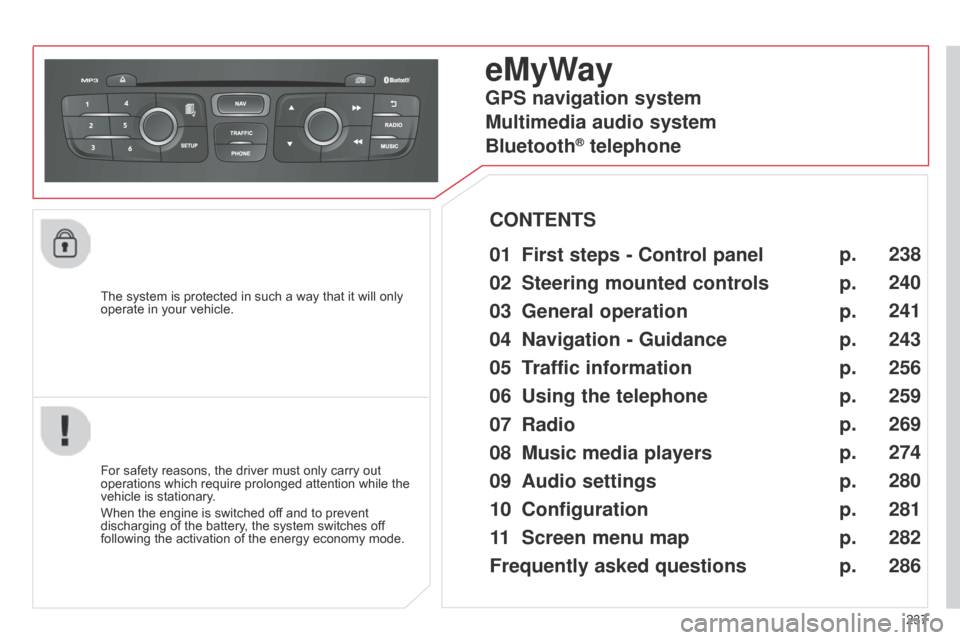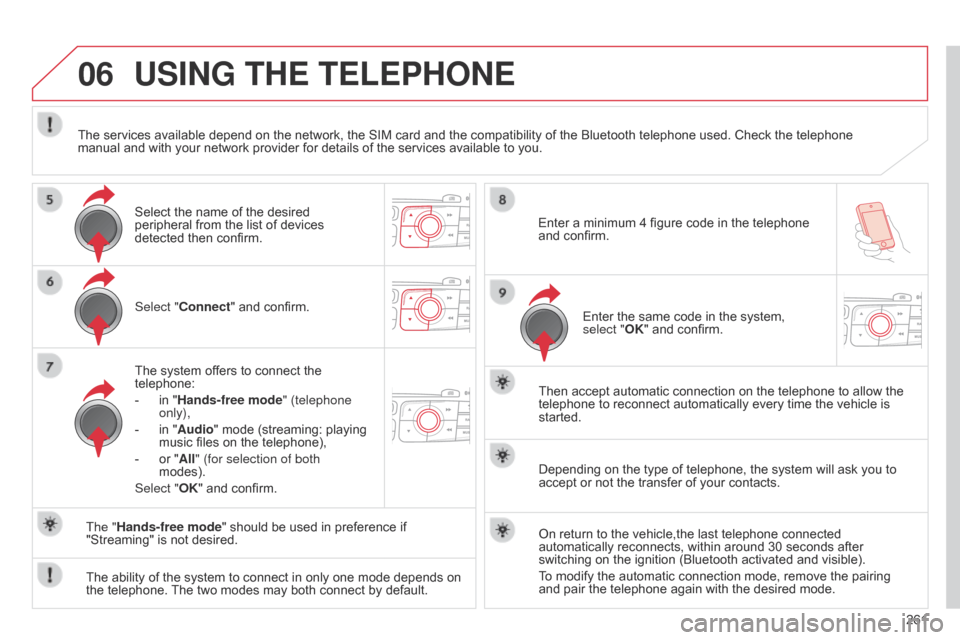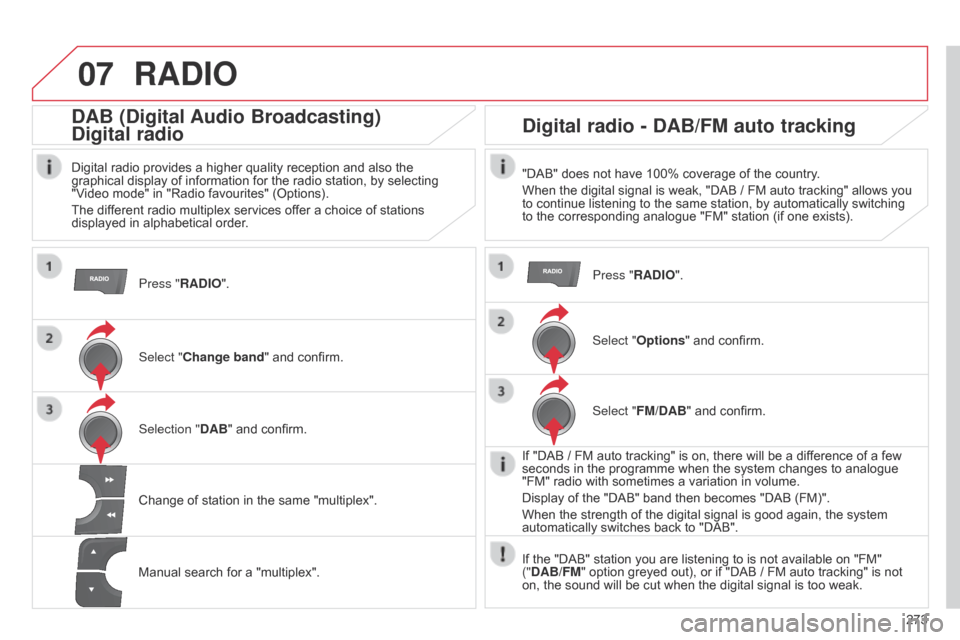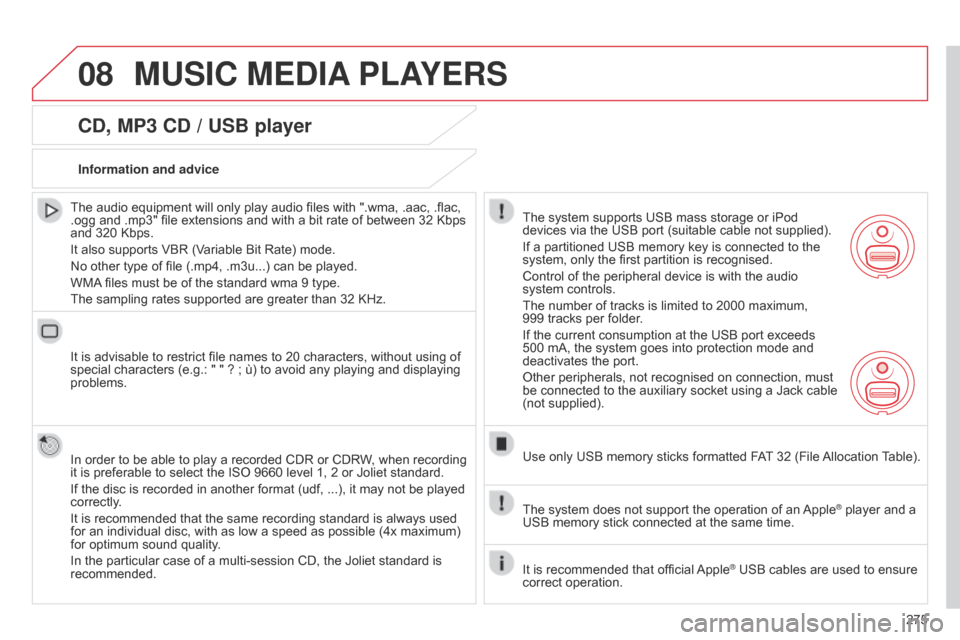ECO mode Citroen C4 DAG 2014.5 2.G Owner's Guide
[x] Cancel search | Manufacturer: CITROEN, Model Year: 2014.5, Model line: C4 DAG, Model: Citroen C4 DAG 2014.5 2.GPages: 340, PDF Size: 12.89 MB
Page 227 of 340

225
C4-2_en_Chap12_caracteristique_ed01-2014
* The kerb weight is equal to the unladen weight + driver (75 kg).
**
The
weight
of
the
braked
trailer
can
be
increased,
within
the
GTW
limit,
if
the
GVW
of
the
towing
vehicle
is
reduced
by
an
equal amount. Warning: towing using a lightly loaded towing vehicle may have an adverse effect on its road holding.
PETROL WEIGHTS AND TOWED LOADS ( IN KG )
The GTW and towed load values indicated are valid up to a maximum altitude of 1 000 metres; the towed load mentioned must
be reduced by 10 % for each additional 1 000 metres of altitude.
When
towing, the maximum authorised speed is reduced (comply with the legislation in force in your country).
High
ambient
temperatures
may
result
in
a
reduction
in
the
performance
of
the
vehicle
to
protect
the
engine;
if
the
ambient
temperature
is above 37 °C, limit the towed load.
Petrol engine
VTi 95 THP 110VTi 120
Gearbox Manual Manual Manual Automatic
Model code:
NC... 8FR0HNZ6
HNZ6/1 -/2 5FS05FS9
5FS9/D
-
Unladen
weight
1 200
1 200
1 205
1 270
-
Kerb
weight*
1 275
1 275
1 280
1 345
-
Gross
vehicle weight (GVW)
1 720
1 770
1 765
1 755
-
Gross
train weight (GTW)
on
a 12 % gradient
2 920
2 970
3 065
3 055
-
Braked
trailer (within the GTW limit)
on
a 12 % gradient
1 200
1 200
1 300
1 300
-
Braked
trailer**
(with
load
transfer
within
the
GTW
limit)
1 450
1 450
1 550
1 550
-
Unbraked
trailer
635635640670
-
Recommended
nose weight
75757575
12
TECHNICAL DATA
Page 228 of 340

226
C4-2_en_Chap12_caracteristique_ed01-2014
* The kerb weight is equal to the unladen weight + driver (75 kg).
**
The
weight
of
the
braked
trailer
can
be
increased,
within
the
GTW
limit,
if
the
GVW
of
the
towing
vehicle
is
reduced
by
an
equal amount. Warning: towing using a lightly loaded towing vehicle may have an adverse effect on its road holding.
The
GTW
and
towed
load
values
indicated
are
valid
up
to
a
maximum
altitude
of
1
000
metres;
the
towed
load
mentioned
must
be reduced by 10 % for each additional 1 000 metres of altitude.
When
towing, the maximum authorised speed is reduced (comply with the legislation in force in your country).
High
ambient
temperatures
may
result
in
a
reduction
in
the
performance
of
the
vehicle
to
protect
the
engine;
if
the
ambient
temperature
is above 37 °C, limit the towed load.
Petrol engine
e-THP 130THP 155
Gearbox ManualElectronic
Model code:
NC... HNYM/S
HNYM/1S 5FV8/P
-
Unladen
weight
1 205
1 275
-
Kerb
weight*
1 280
1 350
-
Gross
vehicle weight (GVW)
1 790
1 805
-
Gross
train weight (GTW)
on
a 12% gradient
3 090
3 205
-
Braked
trailer (within the GTW limit)
on
a 12% gradient
1 300
1 400
-
Braked
trailer** (with load transfer within the
GTW
limit)
1 550
1 650
-
Unbraked
trailer
640675
-
Recommended
nose weight
7575
12
TECHNICAL DATA
Page 231 of 340

229
C4-2_en_Chap12_caracteristique_ed01-2014
* The kerb weight is equal to the unladen weight + driver (75 kg).
**
The
weight
of
the
braked
trailer
can
be
increased,
within
the
GTW
limit,
if
the
GVW
of
the
towing
vehicle
is
reduced
by
an
equal amount. Warning: towing using a lightly loaded towing vehicle may have an adverse effect on its road holding.
DIESEL WEIGHTS AND TOWED LOADS ( IN KG )
The GTW and towed load values indicated are valid up to a maximum altitude of 1 000 metres; the towed load mentioned must
be reduced by 10 % for each additional 1 000 metres of altitude.
When
towing, the maximum authorised speed is reduced (comply with the legislation in force in your country).
High
ambient
temperatures
may
result
in
a
reduction
in
the
performance
of
the
vehicle
to
protect
the
engine;
if
the
ambient
temperature
is above 37 °C, limit the towed load.
Diesel engine
HDi 90 HDi 90 FAP BlueHDi 100 e-HDi 115
Gearbox Manual ManualManualManual
Model code:
NC... 9H j C
9H j C/1
9HP0 BHY6
BHY6/1 BHY6/2S 9HD8/S
9HD8/1S 9HD8/2S
-
Unladen
weight
1 248 1 205 1 200 1 205 1 280 1 280
-
Kerb
weight*
1 323 1 280 1 275 1 280 1 355 1 355
-
Gross
vehicle weight (GVW) 1 745 1 790 1 830 1 840 1 820 1 820
-
Gross
train weight (GTW)
on
a 12 % gradient
2 545 2 890 3 130 3 140 3 120 2 220
-
Braked
trailer (within GTW limit)
on
12 % gradient
800 1 100 1 300 1 300 1 300 400
-
Braked
trailer**
(with
load
transfer
with
the GTW limit)
1 050 1 350 1 550 1 550 1 550 600
-
Unbraked
trailer
640 640 635 640 670 400
-
Recommended
nose weight
757575757575
12
TECHnICaL daTa
Page 232 of 340

230
C4-2_en_Chap12_caracteristique_ed01-2014
* The kerb weight is equal to the unladen weight + driver (75 kg).
**
The
weight
of
the
braked
trailer
can
be
increased,
within
the
GTW
limit,
if
the
GVW
of
the
towing
vehicle
is
reduced
by
an
equal amount. Warning: towing using a lightly loaded towing vehicle may have an adverse effect on its road holding.
The
GTW
and
towed
load
values
indicated
are
valid
up
to
a
maximum
altitude
of
1
000
metres;
the
towed
load
mentioned
must
be reduced by 10 % for each additional 1 000 metres of altitude.
When
towing, the maximum authorised speed is reduced (comply with the legislation in force in your country).
High
ambient
temperatures
may
result
in
a
reduction
in
the
performance
of
the
vehicle
to
protect
the
engine;
if
the
ambient
temperature
is above 37 °C, limit the towed load.
Diesel engine
e-HDi 115BlueHDi 115 BlueHDi 120 HDi 150 FAP
Gearbox ElectronicManual Manual Manual
Model code:
NC... 9HD8/1PS 9HD8/2PSBHXM/S
BHXM/1S -/2S BHZM/S
BHZM/1S -/2S RHE8
RHE8/1
-
Unladen
weight
1 205 1 205 1 280 1 280 1 320
-
Kerb
weight*
1 280 1 280 1 355 1 355 1 395
-
Gross
vehicle weight (GVW)
1 825 1 825 1 860 1 860 1 885
-
Gross
train weight (GTW)
on
12 % gradient
3 125 2 225 3 160 3 160 3 385
-
Braked
trailer (within GTW limit)
on
12 % gradient
1 300
4001 300 1 300 1 500
-
Braked
trailer**
(with
load
transfer
with
the GTW limit)
1 550
6001 550 1 550 1 750
-
Unbraked
trailer
635400675675695
-
Recommended
nose weight
7575757575
12
TECHNICAL DATA
Page 233 of 340

231
C4-2_en_Chap12_caracteristique_ed01-2014
WEIGHTS AND TOWED LOADS ( IN KG )
C4 Enterprise versions (2-seat)
The GTW and towed load values indicated are valid up to a maximum altitude of 1 000 metres; the towed load mentioned must
be reduced by 10 % for each additional 1 000 metres of altitude.
When
towing, the maximum authorised speed is reduced (comply with the legislation in force in your country).
High
ambient
temperatures
may
result
in
a
reduction
in
the
performance
of
the
vehicle
to
protect
the
engine;
if
the
ambient
temperature
is above 37 °C, limit the towed load.
Diesel engine
HDi 90 FAP e-HDi 115 BlueHDi 100 BlueHDi 120
Gearbox Manual Manual Manual Manual
Model code:
NR... 9HP0
9HP0/1 9HD8/1S
9HD7/1S
BHY6/1 BHZM/1S
-
Unladen
weight
1 313
1 283
1 326
1 389
-
Gross
vehicle weight (GVW)
1 745
1 810
1 775
1 840
-
Payload
(including the driver)
432527449451
-
Gross
train weight (GTW)
on
a 12 % gradient
2 845
3 110
3 075
3 090
-
Braked
trailer (within the GTW limit)
on
a 12 % gradient
1 100
1 300
1 300
1 250
-
Unbraked
trailer
635670650685
-
Recommended
nose weight
75757575
12
TECHNICAL DATA
Page 239 of 340

237
C4-2_en_Chap13b_RT6_ed01-2014
The system is protected in such a way that it will only operate in your vehicle.
eMyWay
01 First steps - Control panel
For safety reasons, the driver must only carry out operations
which require prolonged attention while the
vehicle
is stationary.
When
the engine is switched off and to prevent
discharging
of the battery, the system switches off
following
the activation of the energy economy mode.
CONTENTS
02
Steering mounted
controls
03
General operation
04
Navigation
- Guidance
05
T
raffic information
06
Using
the telephone
07
Radio
08
Music media players
09
Audio
settings
10
Configuration
11
Screen menu
map
Frequently asked questions p.
p.
p.
p.
p.
p.
p.
p.
p.
p.
p.
p. 238
240
241
243
256
259
269
274
280
281
282
286
GPS navigation system
Multimedia audio system
Bluetooth
® telephone
Page 243 of 340

03
241
C4-2_en_Chap13b_RT6_ed01-2014
For the details of the menus, refer to the "Screen menu map" section.
For
cleaning
the
screen,
the
use
of
a
soft,
non-abrasive
cloth
(spectacles
cloth)
is
recommended,
with
no
additional
product.
"TRIP COMPUTER"
(Permanent
display)
"RADIO" SETUP:
PARAMETERS
date
and
time,
display
configuration,
sound,
vehicle
settings.
Changing
the audio source:
RADIO: RADIO broadcasts.
MUSIC: playing MUSIC.
Press the MODE
button
several
times
in
succession
for
access
to
the
following displays:
GENERAL
OPERATION
"FULL SCREEN MAP"
"MAP IN WINDOW "
(If
navigation guidance in
progress)
Page 263 of 340

06
261
C4-2_en_Chap13b_RT6_ed01-2014
Select "Connect" and confirm.
The system offers to connect the
telephone:
-
in
"Hands-free mode" (telephone
only),
-
in
"Audio" mode (streaming: playing
music
files on the telephone),
-
or
"All" (for selection of both
modes).
Select "OK"
and confirm. Then
accept automatic connection on the telephone to allow the
telephone
to reconnect automatically every time the vehicle is
started.
The
ability of the system to connect in only one mode depends on
the
telephone.
The
two modes may both connect by default.
USING THE TELEPHONE
The "Hands-free mode" should be used in preference if "Streaming" is not desired.
The
services available depend on the network, the SIM card and the compatibility of the Bluetooth telephone used. Check the telephone
manual
and with your network provider for details of the services available to you.
Depending on the type of telephone, the system will ask you to
accept
or not the transfer of your contacts.
On return to the vehicle,the last telephone connected
automatically
reconnects, within around 30 seconds after
switching
on the ignition (Bluetooth activated and visible).
To
modify the automatic connection mode, remove the pairing
and
pair the telephone again with the desired mode.
Enter
a minimum 4 figure code in the telephone
and
confirm.
Enter the same code in the system,
select "
OK" and confirm.
Select the name of the desired
peripheral
from the list of devices
detected
then confirm.
Page 275 of 340

07
273
C4-2_en_Chap13b_RT6_ed01-2014
RADIO
Press "RADIO".
DAB (Digital Audio Broadcasting)
Digital radio
Digital radio provides a higher quality reception and also the graphical display of information for the radio station, by selecting
"V
ideo mode" in "Radio favourites" (Options).
The
different radio multiplex services offer a choice of stations
displayed
in alphabetical order.
Select "Change band"
and confirm.
Selection " DAB"
and confirm.
Digital radio - DAB/FM auto tracking
"DAB" does not have 100% coverage of the country.
When the digital signal is weak, "DAB / FM auto tracking" allows you
to
continue listening to the same station, by automatically switching
to
the corresponding analogue "FM" station (if one exists).
Change
of
station
in
the
same
"multiplex".
Manual
search
for
a
"multiplex". Press "RADIO".
Select "Options
"
and confirm.
Select "FM/DAB"
and confirm.
If
"DAB / FM auto tracking" is on, there will be a difference of a few
seconds
in the programme when the system changes to analogue
"FM"
radio with sometimes a variation in volume.
Display
of the "DAB" band then becomes "DAB (FM)".
When
the strength of the digital signal is good again, the system
automatically
switches back to "DAB".
If
the "DAB" station you are listening to is not available on "FM"
("
DAB/FM" option greyed out), or if "DAB / FM auto tracking" is not
on,
the sound will be cut when the digital signal is too weak.
Page 277 of 340

08
275
C4-2_en_Chap13b_RT6_ed01-2014
MUSIC MEDIA PLAYERS
CD, MP3 CD / USB player
The audio equipment will only play audio files with ".wma, .aac, .flac, .ogg
and .mp3" file extensions and with a bit rate of between 32 Kbps
and
320 Kbps.
It
also supports VBR (Variable Bit Rate) mode.
No
other type of file (.mp4, .m3u...) can be played.
WMA
files must be of the standard wma 9 type.
The
sampling rates supported are greater than 32 KHz.
It
is advisable to restrict file names to 20 characters, without using of
special
characters (e.g.: " " ? ; ù) to avoid any playing and displaying
problems.
In
order to be able to play a recorded CDR or CDRW, when recording
it
is preferable to select the ISO 9660 level 1, 2 or Joliet standard.
If
the disc is recorded in another format (udf, ...), it may not be played
correctly
.
It
is recommended that the same recording standard is always used
for
an individual disc, with as low a speed as possible (4x maximum)
for
optimum sound quality.
In
the particular case of a multi-session CD, the Joliet standard is
recommended.Information and advice
The
system supports USB mass storage or iPod
devices
via the USB port (suitable cable not supplied).
If
a partitioned USB memory key is connected to the
system,
only the first partition is recognised.
Control
of the peripheral device is with the audio
system
controls.
The
number of tracks is limited to 2000 maximum,
999
tracks per folder.
If
the current consumption at the USB port exceeds
500
mA, the system goes into protection mode and
deactivates
the port.
Other
peripherals, not recognised on connection, must
be
connected to the auxiliary socket using a Jack cable
(not
supplied).
Use
only USB memory sticks formatted FAT
32 (File
Allocation
T
able).
The
system does not support the operation of an
Apple® player and a USB
memory
stick
connected
at
the
same
time.
It
is
recommended
that
official
Apple® USB cables are used to ensure correct
operation.